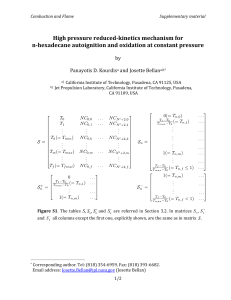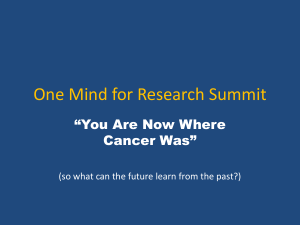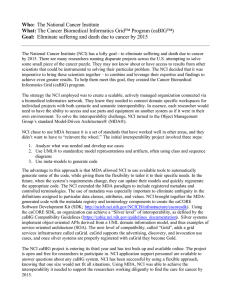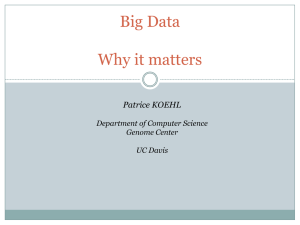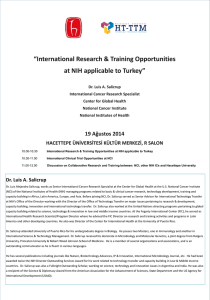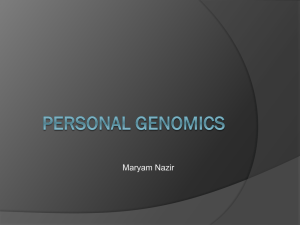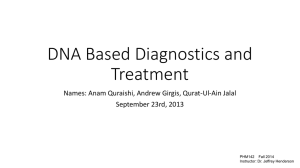Genomics
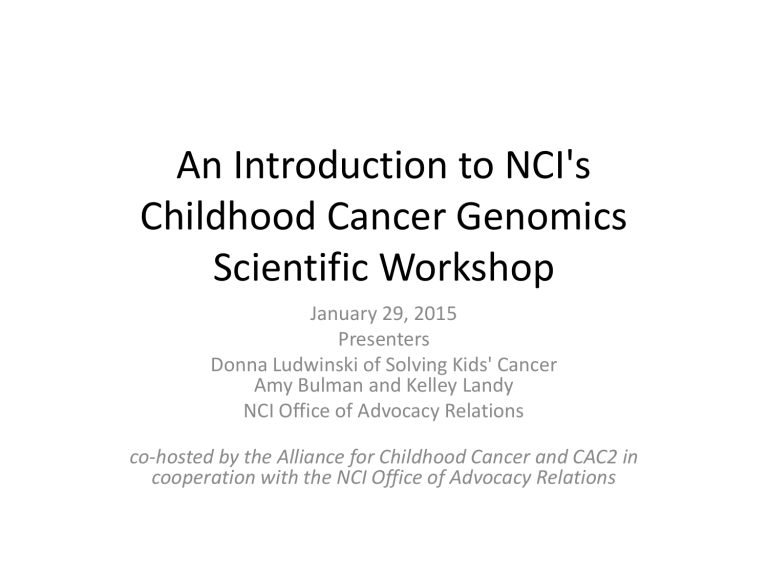
An Introduction to NCI's
Childhood Cancer Genomics
Scientific Workshop
January 29, 2015
Presenters
Donna Ludwinski of Solving Kids' Cancer
Amy Bulman and Kelley Landy
NCI Office of Advocacy Relations co-hosted by the Alliance for Childhood Cancer and CAC2 in cooperation with the NCI Office of Advocacy Relations
Genomics vs Genetics
• Genomics refers to the study of the entire genome of an organism
• Genetics refers to the study of a particular gene
Learning from genomics
• Predisposition?
• Diagnosis and prognosis?
• Therapy?
Genome-wide Association Studies
(GWAS)
• Scan the genomes from many different people
• Look for genetic markers that can predict disease
• Learn how genes contribute to the disease
• Develop better prevention and treatment strategies
DNA
• Molecule that carries genetic instructions in all living things
• Two strands in a double helix
• Strands are held together by bonds between four bases-adenine (A), cytosine (C), guanine (G), and thymine (T)
• The sequence of the bases serves as instructions for assembling protein and RNA molecules
Courtesy: National Human Genome Research Institute
• Genes are passed from parents to offspring and specify traits
• Genes are arranged, one after another on chromosomes
• Humans have approximately
20,000 genes
Gene
DNA sequencing
• DNA sequence information how scientists investigate the functions of genes.
Courtesy: National Human Genome Research Institute
A mutation is a change in a DNA sequence
Courtesy: National Human Genome Research Institute
Mutations can result from
• DNA copying mistakes during cell division
• exposure to ionizing radiation
• exposure to chemicals
• infection by viruses
• Germ line mutations occur in the eggs and sperm and can be passed on to offspring
• Somatic mutations occur in body cells and are not passed on
Personalized vs precision
• Terminology is evolving
• Physicians like to think all medicine in
“personalized”
• Precision refers to more accurately defining patient populations, and appropriate treatment
• “Precision medicine" initiative announced by
President Obama in his Jan 20 State of the Union address.
• Goal is to "lead a new era of medicine, one that delivers the right treatment at the right time."
State of the art
• Fast and low cost sequencing
• Needle biopsies for small tumor samples
• Several current clinical programs
• Cloud data storage
• Advances in bioinformatics
• Lung MAP launched June 2014
Machines for DNA sequencing
• To date 228,000 human genomes have been sequenced worldwide (80% research)
• Sequencing dropped from $3 billion to near
$1000
• Time reduced from 10 years to minutes
• Machines cost $1M
• Francis de Souza, president of Illumina: “The bottleneck now is not the cost—it’s going from
a sample to an answer”
• For DNA sequencing to become routine in medicine first must
– simplify its technology,
– win FDA approval for more diagnostic tests
– develop ways to store DNA data in the cloud
• Illumina announced collaborations with several drug companies and academic centers to develop “panels” that would decode the 100 or so most important cancer genes, to be sold as
FDA-approved kits.
What are the challenges?
• What are the driver mutations?
• Can drugs be developed for each mutation?
• Is drug resistance inevitable?
• How will platforms be validated?
• How will clinical trials be designed?
• Bioethics of biopsies with no therapy recommendations?
• What about tumor heterogeneity?
• Will approved and investigational drugs be available?
• How will unique combination therapies be regulated?
US Department of Health and Human Services
14
National Institutes of Health
NCI
The National Institutes of Health
NINR
NCCIH NIEHS
NHLBI OD NIAMS
NIMHD
NIGMS
NEI
NLM
NHGRI
FIC
Extramural only
NIA
NIMH
NIDDK
NIBIB NINDS
NCATS
NIDCR
NIDCD
NIAAA
NIAID
NICHD
CC
CSR
No Funding Authority
CIT
NIDA
The National Cancer Program
NCI coordinates the National Cancer Program, the nation’s efforts to combat cancer
• NCI’s role in the National Cancer Program is to coordinate, support and conduct cancer research
• Other HHS agencies are partners in the National Cancer
Program and play complementary roles
– FDA coordinates drug approvals
– CDC promotes strategies for preventing and controlling cancer
– CMS administers program to provide insurance coverage for care
Childhood Cancer Genomics:
The Current Landscape and Future Directions
• 2-day scientific workshop on February 4 th and 5 th , 2015
• Leading international researchers and pediatric cancer advocates will discuss opportunities and gaps in the research in 4 main tumor types:
– Brain cancers
– Leukemias
– Embryonal tumors
– Sarcomas
• The workshop will conclude with a discussion on next steps in clinical translation
• An advocate will participate in each panel and NCI will provide a read-out on the workshop to the community
NCI Office of Advocacy Relations
The NCI's Office of Advocacy Relations establishes and builds relationships with key stakeholders in the cancer research community to:
Communicate NCI priorities
Ensure the appropriate involvement of cancer research advocates in Institute activities
Identify areas of alignment to advance research
We are the “touchpoint” for advocates seeking to collaborate with the Institute advocacy.cancer.gov

